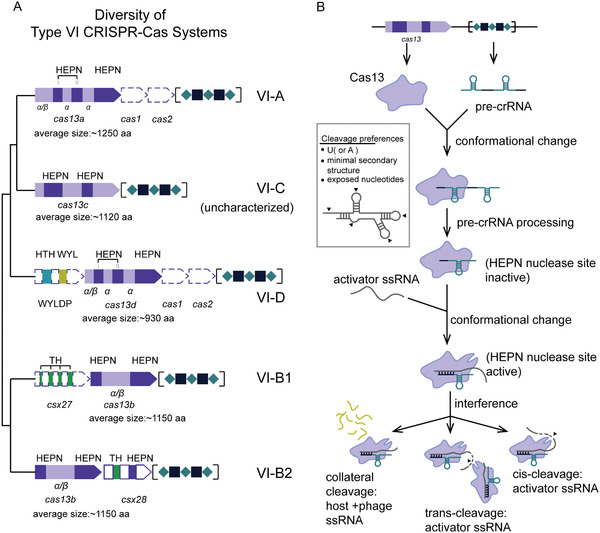Figure 1.

Diversity and functional characteristics of type VI CRISPR‐Cas systems. A) Architecture of CRISPR loci of known subtype of type VI CRISPR‐Cas systems and their phylogenetic relationships. The phylogenetic tree is adopted from refs. [ 53 , 56 ] for illustrative purposes and does not display accurate branch lengths and evolutionary distances. The approximate locations of the two HEPN domains within each Cas effector gene are indicated with dark purple, and the secondary structure composition of the remainder of the gene sequence (light purple) is denoted below the corresponding fragment of the gene (α indicates an α‐helical structure, whereas α/β indicates a mixed α‐helical and β‐sheet structure). The average sizes of each Cas effector are indicated underneath the gene cartoon. The protein‐encoding gene sequences indicated with dashed lines (i.e., Cas1, Cas2 genes in type VI‐A and VI‐D systems, WYL‐domain containing accessory protein in type VI‐D systems and Csx27 accessory protein in type VI‐B1 systems) are not present in all CRISPR loci. CRISPR sequences are denoted with alternating teal rhombuses (direct repeat sequences) and black squares (spacer sequences) in square brackets. The architecture of the type VI‐C CRISPR loci is incomplete as it remains uncharacterized. Gene cartoons are not shown in scale. Abbreviations: HEPN, higher eukaryotes and prokaryotes‐binding domain; WYLDP, WYL domain‐containing protein; HTH, helix‐turn‐helix domain; WYL, WYL domain; TH, putative transmembrane helices. B) General schematic representing functions of type VI CRISPR‐Cas effectors. Upon phage infection, the host bacteria express Cas13 effectors and transcribe the CRISPR sequence into a long precursor CRISPR RNA (pre‐crRNA). Cas13 effectors bind pre‐crRNA and process it autonomously into mature crRNAs, thus forming a Cas13‐crRNA immune surveillance complex. Once the Cas13‐crRNA complex binds a complementary single‐stranded RNA of phage origin (activator ssRNA), hybridization between crRNA spacer and ssRNA is initiated, which is accompanied by a gradual conformational change within the Cas13 effector that eventually results in activation of the HEPN nuclease site (located on the outer surface of the protein). Using Mg2+ as a cofactor, the Cas13 effector (i.e., HEPN nuclease site) activated in this manner subsequently engages in RNA interference, cleaving nonspecifically bound activator ssRNA in cis and other available ssRNAs (both phage and host ssRNA) in trans. Cleavage preferences of Cas13 effectors are shown in the box on the left side of the panel.
